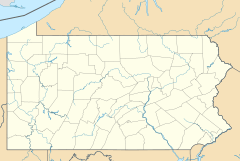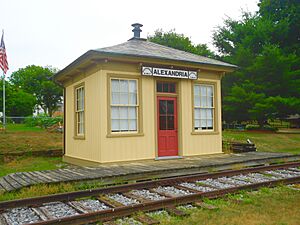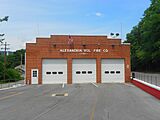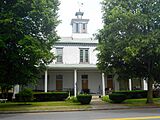Alexandria, Pennsylvania facts for kids
Quick facts for kids
Alexandria, Pennsylvania
|
|
|---|---|
|
Borough
|
|
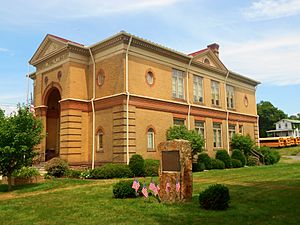
Library
|
|
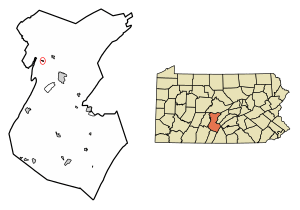
Location of Alexandria in Huntingdon County, Pennsylvania.
|
|
| Country | United States |
| State | Pennsylvania |
| County | Huntingdon |
| Government | |
| • Type | Borough Council |
| Area | |
| • Total | 0.11 sq mi (0.29 km2) |
| • Land | 0.11 sq mi (0.29 km2) |
| • Water | 0.00 sq mi (0.00 km2) |
| Elevation | 705 ft (215 m) |
| Population
(2020)
|
|
| • Total | 384 |
| • Density | 3,368.42/sq mi (1,304.42/km2) |
| Time zone | UTC-5 (Eastern (EST)) |
| • Summer (DST) | UTC-4 (EDT) |
| Zip code |
16611
|
| Area code(s) | 814 |
| FIPS code | 42-00756 |
| GNIS feature ID | 1215264 |
Alexandria is a small town, also known as a borough, located in Huntingdon County, Pennsylvania, in the United States. In 2020, about 388 people lived there. It's a quiet place with a rich history, especially known for its connection to an old trading landmark called "John Hart's log."
Contents
Geography of Alexandria
Alexandria is a very small town. It covers a total area of about 0.1 square miles (0.29 square kilometers). All of this area is land, meaning there are no large lakes or rivers within the borough's official boundaries.
People of Alexandria
The number of people living in Alexandria has changed over many years. Here's a look at how the population has grown and shrunk:
| Historical population | |||
|---|---|---|---|
| Census | Pop. | %± | |
| 1800 | 138 | — | |
| 1810 | 156 | 13.0% | |
| 1820 | 280 | 79.5% | |
| 1840 | 575 | — | |
| 1850 | 601 | 4.5% | |
| 1860 | 534 | −11.1% | |
| 1870 | 556 | 4.1% | |
| 1880 | 484 | −12.9% | |
| 1890 | 438 | −9.5% | |
| 1900 | 406 | −7.3% | |
| 1910 | 432 | 6.4% | |
| 1920 | 440 | 1.9% | |
| 1930 | 443 | 0.7% | |
| 1940 | 442 | −0.2% | |
| 1950 | 443 | 0.2% | |
| 1960 | 381 | −14.0% | |
| 1970 | 495 | 29.9% | |
| 1980 | 435 | −12.1% | |
| 1990 | 420 | −3.4% | |
| 2000 | 408 | −2.9% | |
| 2010 | 349 | −14.5% | |
| 2020 | 388 | 11.2% | |
| 2021 (est.) | 384 | 10.0% | |
| Sources: | |||
In 2000, there were 346 people living in Alexandria. About 139 households were in the borough. This means there were about 3,460 people per square mile.
Many households (32.4%) had children under 18 living with them. About 47% of households were married couples. The average household had about 2.58 people. The average family had about 3 people.
The population was spread out by age. About 23.1% of the people were under 18 years old. About 14.5% were 65 years or older. The average age of people in Alexandria was 37 years old. The population was almost evenly split between males (49.42%) and females (50.58%).
History of Alexandria
The first mention of the area where Alexandria now stands dates back to 1744. This was when a trader named John Hart had a special "log" near here. In 1755, James Sterrat bought 400 acres of land, which included John Hart's log, along the Juniata River. This land eventually became Alexandria.
Early Churches
Before 1785, a religious group called the Hartslog Presbyterian Congregation was formed. They built a simple log worship house, known as Old Hartslog Church. It stood on a hill about a mile north of where Alexandria is today. This spot later became a burial ground.
By 1787, the church building was improved with a floor, windows, a door, a pulpit, and a communion table. In 1794, it was divided into sections and fitted with pews. In 1826, the congregation moved to a new brick building. The old log church was taken down that same year. Some of its logs were even used to build homes in Alexandria.
Transportation and Growth
In the late 1700s, the main way to travel to and from Alexandria was by using the Juniata River. However, this was only possible in summer when the water was deep enough. On May 3, 1808, a new road from Harrisburg to Alexandria opened. This made it much easier to connect with other places.
In 1833, the Juniata Division of the Pennsylvania Canal opened. The promise of better transportation led to a small building boom in Alexandria. However, by 1875, the canal was no longer used. The Pennsylvania Railroad then took over the transportation needs of the area. Around this time, Alexandria's growth slowed down, while nearby towns like Huntingdon and Hollidaysburg grew more quickly.
Hartslog Heritage Day Festival
Alexandria celebrates its history every year with the "Hartslog Heritage Day" festival. This event takes place on the second Saturday of October. It remembers the early days of the borough. In 1744, a trader named John Hart used a large hollowed-out log to feed his horses. This was while he was trading goods.
Early settlers used this log as a landmark to describe their land claims. They called the area "Hartslog Settlement." In 1793, the area was divided into town lots and named Alexandria. The street near where the log was located was named Hartslog Street.
Today, the name "Hartslog Street" is still used. The surrounding area is also known as "Hartslog Valley."
The Hartslog Museum is located on the second floor of the library in Alexandria. It is open one weekend each month and on Hartslog Day. The museum displays old items and antiques from the area. These items show what life was like when Pennsylvania was still home to many Native American tribes. Hartslog Day helps to support the museum.
Notable People
Alexandria has been home to some important people:
- George MacPherson Docherty – A pastor who helped add the phrase "Under God" to the Pledge of Allegiance.
- John Scott, Sr. – He was a member of the U.S. House of Representatives.
- John Scott, Jr. – He was a member of the United States Senate.
See Also
 In Spanish: Alexandria (Pensilvania) para niños
In Spanish: Alexandria (Pensilvania) para niños


